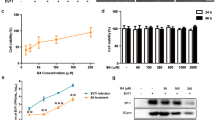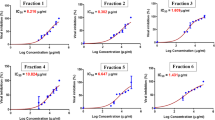Abstract
Grifola frondosa, an edible and medicinal resource, is widely used as functional foods worldwide. To explore bioactive compounds against α-glucosidase, human tumor cells and enterovirus 71 (EV71), eight compounds were isolated from G. frondosa by chromatographic column. Among the isolated compounds, heptadecanoic acid, uridine and adenosine exhibited potent inhibition activity against α-glucosidase, ergosterols and ergosterol-5,8-peroxide showed anti-proliferative activity on tumor cells, while ergosterol and methyl linoleate displayed inhibition against the replication of EV71. Also, to our knowledge, this is the first study to report that fatty acids isolated from G. frondosa show potent inhibition against α-glucosidase and EV71. Further molecular docking results revealed that the active compounds in G. frondosa form hydrogen bonding, hydrophobic interactive and π-stacking with the active sites on the surface of α-glucosidase, CASP3 and VP1 proteins, thus promoting the active compounds to combine with the target protein to form a stable complex, thus playing an antagonistic role. Our results could provide a new active compound and mode of action for G. frondosa to treat diabetes, cancer and EV71-infected patients.



Similar content being viewed by others
Data Availability
All data generated or analyzed during this study are included in this published article (and its supplementary information files).
Abbreviations
- EV71:
-
enterovirus 71
- HFMD:
-
hand-foot-and-mouth disease
- FBS:
-
fetal bovine serum
- DMEM:
-
dulbecco’s modified eagle’s medium
- OCFA:
-
odd-chain fatty acids
- TI:
-
therapeutic index
References
Ma X, Meng M, Han L et al (2015) Immunomodulatory activity of macromolecular polysaccharide isolated from Grifola frondosa. Chin J Nat Med 13(12):906–914. https://doi.org/10.1016/S1875-5364(15)30096-0
Ji H, Chen P, Yu J et al (2019) Effects of heat treatment on the structural characteristics and antitumor activity of polysaccharides from Grifola frondosa. Appl Biochem Biotechnol 188(2):481–490. https://doi.org/10.1007/s12010-018-02936-5
Gu C, Li J, Chao F et al (2007) Isolation, identification and function of a novel anti-HSV-1 protein from Grifola frondosa. Antiviral Res 75(3):250–257. https://doi.org/10.1016/j.antiviral.2007.03.011
Kou L, Du M, Liu P et al (2019) Anti-diabetic and anti-nephritic activities of Grifola frondosa mycelium polysaccharides in diet-streptozotocin-induced diabetic rats via modulation on oxidative stress. Appl Biochem Biotechnol 187(1):310–322. https://doi.org/10.1007/s12010-018-2803-6
Zhao C, Gao L, Wang C et al (2016) Structural characterization and antiviral activity of a novel heteropolysaccharide isolated from Grifola frondosa against enterovirus 71. Carbohydr Polym 144:382–389. https://doi.org/10.1016/j.carbpol.2015.12.005
Chen Y, Liu Y, Sarker MMR et al (2018) Structural characterization and antidiabetic potential of a novel heteropolysaccharide from Grifola frondosa via IRS1/PI3K-JNK signaling pathways. Carbohydr Polym 198:452–461. https://doi.org/10.1016/j.carbpol.2018.06.077
Chen SD, Yong TQ, Xiao C et al (2018) Pyrrole alkaloids and ergosterols from Grifola frondosa exert anti-α-glucosidase and anti-proliferative activities. J Funct Foods 43:196–205. https://doi.org/10.1016/j.jff.2018.02.007
Xu B, Liu M, Ma S et al (2021) 4-Iminooxazolidin-2-one as a bioisostere of cyanohydrin suppresses EV71 proliferation by targeting 3Cpro. Microbiol Spectr 9:e0102521. https://doi.org/10.1128/SPECTRUM.01025-21
Lv Y, Tian N, Wang J et al (2018) Metabolic switching in the hypoglycemic and antitumor effects of metformin on high glucose induced HepG2 cells. J Pharm Biomed Anal 156:153–162. https://doi.org/10.1016/j.jpba.2018.04.029
Tian T, Chen G, Zhang H et al (2021) Personal glucose meter for α-glucosidase inhibitor screening based on the hydrolysis of maltose. Molecules 26(15):4638–4638. https://doi.org/10.3390/MOLECULES26154638
Zhang L, Xu P, Chu M et al (2019) Using 1-propanol to significantly enhance the production of valuable odd-chain fatty acids by Rhodococcus opacus PD630. World J Microbiol Biotechnol 35:164. https://doi.org/10.1007/s11274-019-2748-0
Pfeuffer M, Jaudszus A (2016) Pentadecanoic and heptadecanoic acids: multifaceted odd-chain fatty acids. Adv Nutr 7(4):730–734. https://doi.org/10.3945/an.115.011387
Zenchenko AA, Drenichev MS, Il’Icheva IA et al (2021) Antiviral and antimicrobial nucleoside derivatives: structural features and mechanisms of action. Mol Biol (Mosk) 55(6):786–812. https://doi.org/10.1134/S0026893321040105
Wang JS, Chang YL, Yu YH et al (2012) Cell type-specific effects of Adenosine 5’-triphosphate and pyrophosphate on the antitumor activity of doxorubicin. Cancer Sci 103(10):1811–1819. https://doi.org/10.1111/j.1349-7006.2012.02376.x
Noureldeen AFH, Aziz SW, Shouman SA et al (2022) Molecular design, spectroscopic, DFT, pharmacological, and molecular docking studies of novel ruthenium (III)–schiff base complex: an inhibitor of progression in HepG2 cells. Int J Env Res Pub He 19(20):13624. https://doi.org/10.3390/IJERPH192013624
Tan X, Huang X, Zhu S et al (2011) The persistent circulation of enterovirus 71 in People’s Republic of China: causing emerging nationwide epidemics since 2008. PLoS One 6:e25662. https://doi.org/10.1371/journal.pone.0025662
Liang Z, Wang J (2014) EV71 vaccine, an invaluable gift for children. Clin Transl Immunology 3(10):e28. https://doi.org/10.1038/cti.2014.24
Lin H, Zhou J, Lin K et al (2016) Efficacy of scutellaria baicalensis for the treatment of hand, foot, and mouth disease associated with encephalitis in patients infected with EV71: a multicenter, retrospective analysis. Biomed Res Int 2016:5697571. https://doi.org/10.1155/2016/5697571
Duan C, Wang JC, Liu Y et al (2021) Antiviral effects of ergosterol peroxide in a pig model of porcine deltacoronavirus (PDCoV) infection involves modulation of apoptosis and tight junction in the small intestine. Vet Res 52(1):86. https://doi.org/10.1186/s13567-021-00955-5
Wang N, Yang X, Sun J et al (2019) Neutrophil extracellular traps induced by VP1 contribute to pulmonary edema during EV71 infection. Cell Death Discov 5(1):1–12. https://doi.org/10.1038/s41420-019-0193-3
Snoussi M, Redissi A, Mosbah A et al (2021) Emetine, a potent alkaloid for the treatment of SARS-CoV-2 targeting papain-like protease and non-structural proteins: pharmacokinetics, molecular docking and dynamic studies. J Biomol Struct Dyn 40(20):11–14. https://doi.org/10.1080/07391102.2021.1946715
Funding
This work was supported by Major Special Project of Fujian Province “Research and application of key technologies for innovation and industrialized utilization of Juncao” (2021NZ029009), Fujian Provincial Department of Science and Technology Regional Development Project (2020N3002), Foreign Cooperation Project of Fujian Provincial Department of Science and Technology (2021I0008) and Interdisciplinary integration to promote the high-quality development of Juncao science and Industry (XKJC-712021030).
Author information
Authors and Affiliations
Contributions
Conceptualization, Junqiang He and Ying Huang; Methodology, Junqiang He and Wenyu Xiong; Writing – Original Draft, Junqiang He; Writing Review and Editing, Junqiang He and Ying Huang; Funding Acquisition, Bin Liu and Lina Zhao; Supervision, Bin Liu and Ying Huang.
Corresponding authors
Ethics declarations
Ethics Approval
Not applicable.
Consent to Participate
Not applicable.
Consent for Publication
Not applicable.
Conflict of Interest
The authors have no confict of interests to declare.
Additional information
Publisher’s Note
Springer Nature remains neutral with regard to jurisdictional claims in published maps and institutional affiliations.
Electronic Supplementary Material
Below is the link to the electronic supplementary material.
Rights and permissions
Springer Nature or its licensor (e.g. a society or other partner) holds exclusive rights to this article under a publishing agreement with the author(s) or other rightsholder(s); author self-archiving of the accepted manuscript version of this article is solely governed by the terms of such publishing agreement and applicable law.
About this article
Cite this article
He, J., Xiong, W., Zhao, L. et al. Anti-α-glucosidase, Anti-proliferative and Anti-enterovirus 71 Activity of Secondary Metabolites Identified from Grifola Frondosa. Plant Foods Hum Nutr 78, 783–789 (2023). https://doi.org/10.1007/s11130-023-01106-1
Accepted:
Published:
Issue Date:
DOI: https://doi.org/10.1007/s11130-023-01106-1




